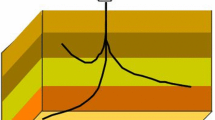Abstract
At present, to analyze the efficiency of the oil field flooding system, proxy models of the capacitance–resistive model (CRM) family are actively used: mathematical models of the material balance formulated in the framework of the electrodynamic analogy. However, with a large number of production and injection wells, the accuracy of modeling decreases due to the set of local minima of the target function. One of the reasons for this ambiguity of the solution is the lack of a priori information on which injection wells really affect a particular production well. The mask of mutual influence (interaction, interference) is determined, which makes it possible to significantly reduce the number of determined mutual influence coefficients. A computational algorithm is proposed in which, instead of solving a multiextremal problem, a sequence of problems with a quadratic target function and convex constraints on variables in the form of simple inequalities is solved. An example of the approbation of the proposed method is given.


Similar content being viewed by others
REFERENCES
K. Aziz and A. Settari, Petroleum Reservoir Simulation (Applied Science, London, 1979).
T. A. Pospelova, S. V. Stepanov, A. V. Strekalov, and S. V. Sokolov, Mathematical Modeling for Decision-Making on Field Development (Nedra, Moscow, 2021) [in Russian].
A. A. Yousef, P. H. Gentil, J. L. Jensen, and L. W. Lake, “A capacitance model to infer interwell connectivity from production and injection rate fluctuations,” in SPE Annual Technical Conference and Exhibition, Dallas, Texas, 2005, Paper SPE-95322-MS. https://doi.org/10.2118/95322-MS
S. V. Stepanov, S. V. Sokolov, A. A. Ruchkin, A. V. Stepanov, A. V. Knyazev, and A. V. Korytov, “Considerations on mathematical modeling of producer-injector interference,” Vestn. Tyumen. Gos. Univ. Fiz.-Mat. Model. Neft’, Gaz, Energ. 4 (3), 146–164 (2018). https://doi.org/10.21684/2411-7978-2018-4-3-146-164
M. Sayarpour, Development and Application of Capacitance-Resistive Models to Water/CO2 Floods, Ph. D. Dissertation (University of Texas, Austin, TX, USA, 2008). https://doi.org/10.13140/RG.2.1.1798.3847
J. S. Kim, L. W. Lake, and T. F. Edgar, “Integrated capacitance-resistance model for characterizing waterflooded reservoirs,” in Proc. 2012 IFAC Workshop on Automatic Control in Offshore Oil and Gas Production, Trondheim, Norway, IFAC Proc. Vol. 45 (8), 19–24 (2012). https://doi.org/10.3182/20120531-2-NO-4020.00009
I. F. Khatmullin, A. P. Tsanda, A. M. Andrianova, S. A. Budenny, A. S. Margarit, V. A. Lushpeyev, M. V. Simonov, and D. S. Perets, “Semi-analytical models for calculating well interference: limitations and applications,” Neft. Khoz., No. 12, 38–41 (2018). https://doi.org/10.24887/0028-2448-2018-12-38-41
M. Yu. Danko, L. S. Brilliant, and A. S. Zavyalov, “Application of dynamic material balance method and CRM method (capacitance–resistive models) for reserves assessment in Achimov and Bazhenov reservoirs,” Nedropolzovanie XXI Vek, No. 4 (80), 76–85 (2019).
I. V. Afanaskin, P. V. Kryganov, A. A. Glushakov, and P. V. Yalov, “CRM well interference models for evaluating reservoir filtration and volumetric properties from production data,” Usp. Kibern. 1 (1), 17–27 (2020). https://doi.org/10.51790/2712-9942-2020-1-1-3
R. W. Holanda, E. Gildin, J. L. Jensen, L. W. Lake, and C. S. Kabir, “A state-of-the-art literature review on capacitance resistance models for reservoir characterization and performance forecasting,” Energies, 11, 3368 (2018). https://doi.org/10.3390/en11123368
A. D. Bekman, S. V. Stepanov, A. A. Ruchkin, and D. V. Zelenin, “ A new algorithm for finding CRM-model coefficients,” Vestn. Tyumen. Gos. Univ. Fiz.-Mat. Model. Neft’, Gaz, Energ. 5, 164–185 (2019). https://doi.org/10.21684/2411-7978-2019-5-3-164-185
S. V. Stepanov, A. D. Bekman, A. A. Ruchkin, and T. A. Pospelova, Maintenance of Oil Field Development Using CRM Models (Ekspress, Tyumen, 2021) [in Russian].
F. Kartayev, Introduction to Econometrics (Ekon. Fak. Mosk. Gos. Univ. im. M. V. Lomonosova, Moscow, 2019) [in Russian].
S. V. Stepanov, A. N. Tyrsin, A. A. Ruchkin, and T. A. Pospelova, “Using entropy modeling to analyze the effectiveness of the waterflooding system,” Neft. Khoz., No. 6, 62–67 (2020). https://doi.org/10.24887/0028-2448-2020-6-62-67
A. V. Panteleyev and T. A. Letova, Optimization Methods in Examples and Problems, 4th ed. (Lan’, St. Petersburg, 2015) [in Russian].
G. E. P. Box, G. M. Jenkins, G. C. Reinsel, and G. M. Ljung, Time Series Analysis: Forecasting and Control, 5th ed. (Wiley, New York, 2015).
A. N. Tyrsin, Vector Entropy Modeling of Multidimensional Stochastic Systems (Nauka, Moscow, 2022) [in Russian].
S. A. Aivazyan, I. S. Yenyukov, and L. D. Meshalkin, Applied Statistics: Study of Relationships (Finansy i Statistika, Moscow, 1985) [in Russian].
NLopt Algorithms. https://nlopt.readthedocs.io/en/latest/NLopt_Algorithms/. Cited March 22, 2023.
Author information
Authors and Affiliations
Corresponding authors
Ethics declarations
The authors declare that they have no conflicts of interest.
Rights and permissions
About this article
Cite this article
Tyrsin, A.N., Stepanov, S.V., Ruchkin, A.A. et al. Increasing the Reliability of Well Interaction Modeling for the Analysis of the Efficiency of the Flooding System. Math Models Comput Simul 15, 1092–1103 (2023). https://doi.org/10.1134/S2070048223060170
Received:
Revised:
Accepted:
Published:
Issue Date:
DOI: https://doi.org/10.1134/S2070048223060170




